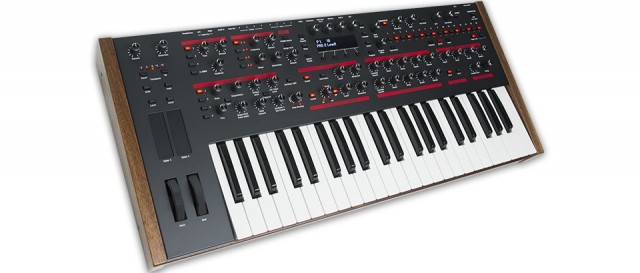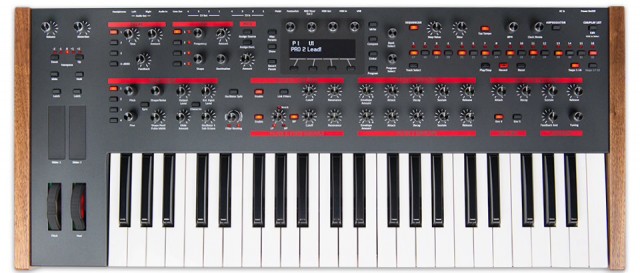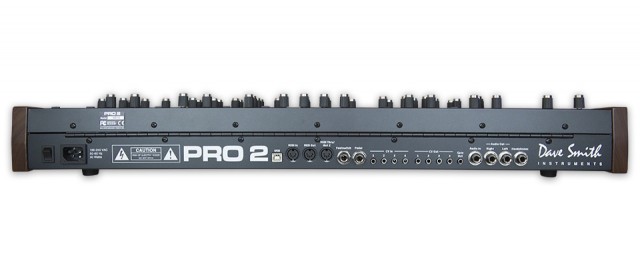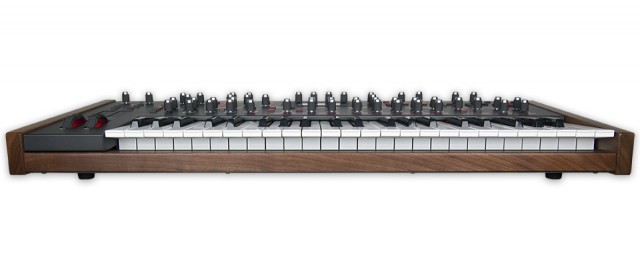In a world full of monosynths, how do you stand out from the crowd? Easy: build a monosynth that thinks it’s a high-end synth workstation.
Never has so much power been built into one note. Looking at the Dave Smith Instruments Pro 2, what you get is really something resembling the Prophet 12, an instrument that’s been getting loads of acclaim of late. The rich synth architecture, the controls and modulation, the ample connectivity opportunities (including CV) — everything’s there. In that basic mold, though, the Pro 2 has an architecture all its own – and, by default, it’s monophonic. And that’s not an absurd concept, either. Robert Moog himself praised monophony as a means of approximating instruments and the human voice. And, of course, it’s less expensive.
A source tells CDM that you can expect the Pro 2 to list for US$1995 and ship late in July. That means this is a monosynth for serious analog synth lovers and deeper pockets.
Now, on to the surprises.
This monosynth is actually not a monosynth, as it’s not only monophonic. It’s not all-analog, but it is better at playing with analog than a lot of instruments that are. And the “2” really belies the fact that most of the bits on it come in fours – or (in the case of the modulation matrix) even 16.
Also, while it looks like a monophonic Prophet 12, it actually isn’t.
Got that? Let’s look a bit closer.
It’s not a mono Prophet 12. The Pro 2 looks like a Prophet 12, but its internal design is different. There’s a new dual-analog filter, a new step sequencer, a digital bucket-brigade delay, and new oscillators.
Also, DSI says that it “redefines the word fat.” But that means we know even less what the word “fat” actually means. Let’s skip that and move on.
Dave’s “most powerful mono synth ever” isn’t. Well, it isn’t only a mono synth, that is. It’s technically a paraphonic synth, with true four-voice operation – each of the four oscillators can be assigned its own envelope. And that makes some sense, as both the oscillators themselves and the modulation into which you can route them are deep enough that you’d hardly complain about the range of timbres you could use in four-voice mode.
In short: yes, you can happily play chords on the Pro 2.
It’s a digital/analog hybrid. I feel DSI is at its best in the digital/analog hybrid domain; some of our favorite DSI instruments (Evolver, for instance) made great use of digital oscillators. So, this is actually promising.
What’s what? The oscillators themselves are digital. That’s a good thing, because it means you’re not restricted to analog wave shapes: the four “high-resolution” oscillators can also produce various complex waveforms (superwaves!), and can be set up for frequency and amplitude modulation. More waveforms, FM and AM means a synth that’s more sonically versatile and that you’re far less likely to tire of.
There are some unique additions to those oscillators, too. Grouped together as Character controls, DSI has added high- and low-frequency boost to color the oscillators, bit and sample rate reduction if you’d like to go more digital, or tape saturation emulation if you’d like to go more (faux) analog.
Dual filters from Tom and Dave. It’s about time we get to hear something that isn’t, say, a Moog ladder filter. (All due respect to that filter, yes – but eating only chocolate all the time isn’t much fun, either.)
And that’s absolutely what you get on the Pro 2, with one filter from the Dave Smith lineage, and one from the Tom Oberheim lineage. (Tom is Dave’s neighbor in California, though he didn’t directly contribute to this.)
Behind filter door #1: 4-pole, low pass, Prophet-5 inspired.
Behind filter door #2: Multi-mode, continuously variable between low-pass, notch, high-pass; band-pass option. Oberheim SEM-inspired.
You can use these together in serial, in parallel, or a mix of the two.
Sequencer.
32 steps, 16 tracks, real-time input, rests, variable-length sequences, MIDI and audio sync. You can also control any parameter in the modulation matrix.
Modular I/O. Four rear-panel CV ins and outs and dedicated gate. But this isn’t just about jacks – it’s finally about using those jacks for something useful and flexible. You can send the oscillators, LFOs, envelopes, and the sequencer tracks.
MIDI doesn’t skimp, either – of course there’s a dedicated MIDI Thru on a keyboard from the man who fathered the format.
That makes this monosynth a compelling hub for other gear – doubly interesting when we’ve heard reader complaints that, for instance, the new Elektron gear doesn’t do more in this category.
All the fixin’s, modulation-wise. If you’re dropping two grand on a monosynth, you better get more than just some interesting oscillators and filters, of course.
And it seems the Pro 2 delivers here, as well. Take the delay section, alone. You get three digital delays, each with pan and filter controls. Then there’s a fourth digital bucket-brigade delay, which they market as “analog style.”
And then we get into the other modulation:
- Envelope generators. Four of them. Each with five stages. Each loopable.
- LFOs. Four of them. Each with slew and phase offset. Each routable anywhere (including those CV outs)
- Arpeggiator.
- Tuned feedback.
- Programmable analog distortion.
- Modulation matrix. Sixteen slots.
And the keyboard itself is lovely.
You can get some fantastic bargains in mono synths with keyboards – Arturia’s MicroBrute, Moog’s Sub Phatty, and KORG’s MS-20 mini spring to mind, and they’re all brilliant.
But those instruments, while deeply satisfying to play, definitely don’t feel like high-end keyboards. If you want an anchor in the studio or on the stage, the Pro 2 more closely resembles that.
There’s a three-and-a-half octave, full-sized, semi-weighted keyboard with channel aftertouch. There are proper pitch and mod wheels, backlit (Moog Voyager style). There are two independent pressure-sensitive touch sliders Dave so enjoys. And there are, naturally, loads of controls and I/O.
All in all, this looks like a flagship, no-compromise synth wonder. It fills a nice niche in the market, and frankly, I find the architecture even more appealing than on the Prophet 12 – extra voices be damned. I can’t wait to play it, and I imagine I’m not alone. This could be the enviable synth of 2014. Stay tuned.
Full specs:
Oscillators
Four DSP-based oscillators plus one sine wave sub oscillator
Four classic wave shapes (saw, square, triangle, sine) per oscillator
Twelve selectable complex shapes per oscillator
13 Superwaves
Three noise types per oscillator: white, pink, violet
Shape modulation/pulse width/superwave detune amount
Oscillator cross modulation: frequency modulation (FM) and amplitude modulation (AM)
Hard sync, individual Glide, Oscillator SlopParaphonic Playability
True 4-voice paraphonic mode with individually-gated envelopes per oscillatorCharacter Effects
Five high-quality digital effects. Thicken the signal and add harmonics or completely destroy the signal pre-filter.
Girth and Air are high and low shelf equalizers with harmonic excitement. Useful for thickening and/or adding air to the signal.
Hack and Decimate are sample and bit rate reduction algorithms which can add subtle grit or completely trash the signal. It’s harsh yet musical.
Drive is a soft saturator for adding soft distortion and harmonic content to the signalFilters
Dual analog filters operate in serial or parallel
Filter 1 is a 4-pole resonant analog low-pass filter inspired by the original Prophet-5 filter.
Filter 2 is a 2-pole resonant analog state-variable filter inspired by the Oberheim SEM filter and can be continuously varied between low-pass, notch, and high-pass operation, with an optional band-pass mode.
Oscillator Split allows oscillators 1 & 2 to be sent to Filter 1 and oscillators 3 & 4 to Filter 2.
Feedback and DelayTuned Feedback
Three-tap syncable delay with feedback and amount controls, pan, and high-pass and low-pass filtering, all per delay. A separate fourth delay is a digital bucket-brigade delay (BBD) for analog-style effects.Envelopes
Five Delay + ADSR envelopes (Filter 1, Filter 2, VCA , and two Auxiliary envelopes)
Auxiliary envelopes 4 and 5 freely assignable to multiple modulation destinations
All envelopes can repeat/loopLFOs
Four syncable LFOs with phase offset and slew per LFOModulation
16 x 2 modulation matrix with over 50 mod sources and over 140 mod destinations
Parameters that can be sent to CV outputs include oscillators, LFOs, envelopes, sequencer tracks and any other source within the modulation matrix. Runs up to audio rates.
Gate Out for triggering external CV-compatible devices; any CV in can be used as a gate input.
Control Voltage Ins & Outs and Gate Out
Four 1-volt-per-octave control voltage inputs and outputs for interfacing with modular synths and other CV-compatible devices
Modulation assignment buttons enable quick and easy modulation routing.
Mod Matrix runs up to audio rates.Sequencer
Advanced step sequencer provides up to 32 steps per sequence and up to 16 tracks.
Supports real-time input, rests, and variable-length sequences
Syncs to MIDI clock and external audio and CV input
Sequences can control not only oscillator pitch but any parameter in the modulation matrix.Arpeggiator
Sophisticated arpeggiator with up, down, up+down, random, assign modes
Supports real-time input, rests, and variable-length sequences
Re-latching arpeggiationProgrammable Distortion
Stereo analog distortionControls
More than 50 knobs and 65 buttons enable deep and comprehensive editing with minimal menu diving.
Backlit pitch and mod wheels are easily visible in low-light situations and have a smooth yet precise feel and response.
Independently adjustable upper and lower pitch wheel range
Two assignable position- and pressure-sensitive latchable touch sliders for enhanced interactivity and control
Full-sized, three-and-a-half-octave, semi-weighted keyboard with velocity and aftertouchMemory
396 user and 396 factory programs
Playlist mode for generating easily accessible setlists of your favorite programsI/O
1 MIDI In, 1 MIDI out, and 1 MIDI Thru/Out 2 port
USB port for bidirectional MIDI communication
4 CV inputs (4 x 1/8″ jack)
4 CV outputs (4 x 1/8″ jack)
1 Gate Out (1/8″ jack))
1 Sustain/footswitch input
1 expression pedal input
1 external audio input (1/4″ phone jack)
Main stereo output (2 x 1/4″ phone jack)
Headphone out (stereo 1/4″ phone jack)Power
1 universal IEC AC power inlet for internal power supply
Operates worldwide on voltages between 100-240v, 50-60Hz, 30 watts maximum power consumptionPhysical Specs
Walnut end panels and trim
Dimensions: approximately 29.2″ L x 12.8″ W x 4.15″ H (74.2 cm x 32.5 cm x 10.5 cm)
Weight: 18.7 lbs (8.5 kg)



